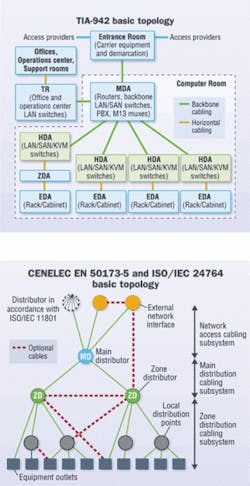Specifications for designing and implementing a data center's structured cabling system exist in a sundry of standards, with more on the horizon.
Data centers are at the forefront of standards development today. From February through May, Cabling Installation & Maintenance covered everything from the Environmental Protection Agency's report to Congress calling for data center energy measurement standards, and the new Energy Star specification for servers, to the upcoming rewrites of the TIA-606-A Administration and 607 Bonding and Grounding standards to better address data center applications. But those are just a few of the standards addressing cabling systems within data centers.
The TIA-942 Telecommunications Infrastructure Standard for Data Centers was published in April 2005 to address site space and layout, cabling infrastructure, reliability, and environmental considerations. TheEuropean Committee for Electrotechnical Standardization (CENELEC; www.cenelec.eu) EN 50173-5 Information Technology—Generic Cabling Systems Part 5: Data Centres was published in May 2007 to address cabling infrastructure in the data center environment. The ISO/IEC 24764 Information Technology—Generic Cabling for Data Center Premises, which is similar to theCENELEC standard, will likely be published in 2009.
When planning a data center, designers also must consider a slew of standards from other organizations, including the American Society of Heating, Refrigerating, and Air-conditioning Engineers (ASHRAE; www.ashrae.org); the National Fire Protection Association (NFPA; www.nfpa.org, publisher of the National Electrical Code); the National Electrical Contractors Association (NECA; www.necanet.org); and more from other recognized and accredited standards organizations.
Now BICSI (www.bicsi.org) is working on a data center standard that will complement and reference other applicable data center standards and guidelines. Clearly, those who design, build, and operate data centers must concern themselves with more than just one or two standards.
The big three
The TIA-942, CENELEC EN 50173-5, and the upcoming ISO/IEC 24764, which used CENELEC as its starting point, are considered the three primary data center telecommunications standards.
"TIA-942 is more comprehensive, covering a wide range of subjects like data center pathways, spaces, application distances, site selection, access-provider coordination, administration, tiers, and general information surrounding electrical, mechanical, and architecturalconsiderations," says Jonathan Jew, vice chairman of TR-42.6 and president of J&M Consultants (www.j-and-m.com)."On the other hand, the CENELEC and ISO/IEC standardslimit their scope to cabling, and do a very good job of it."
According to Jew, both CENELEC and ISO/IEC use a similar topology called out in TIA-942, but use different terminology and provide more detail regarding cabling system specifications like topologies, reference channels, and channel lengths. For example, the TIA uses the term "entrance room" while both CENELEC and ISO standards use "external network interface" (ENI) to refer to the access-provider demarcation point.
One of the key differences distinguishing the TIA standard from the CENELEC and ISO/IEC standards is the type ofcable and connectors specified. "TIA-942 supports 734- and 735-type coax for E-1, E-3, and T-3 circuits while the CENELECand ISO/IEC standards do not," says Jew. "TIA-942 Addendum 1, published on April 8, provides additional requirements for connectors used for 75-¿ coaxial cabling in data centers.It also allows for longer horizontal cabling originating fromthe main distribution area (MDA) for coaxial cabling, and permits longer distances for E-1, T-1, E-3, and T-3 circuits."
Jew adds, "For cabling, other than that originating from the ENI, CENELEC specifies a minimum of Category 6, and ISO/IEC will specify a minimum of Augmented Category 6."
For copper cabling, TIA-942 currently specifies 100-¿ twisted-pair cable per TIA-568-B.2, with Category 6 recommended. For multimode fiber, TIA-942 specifies 50/125- or 62.5/125-µm fiber, with 850-nm laser-optimized 50/125-µm recommended. Because the ISO/IEC standard is the newest data center standard in development, it will ultimately specify the latest copper and fiber cabling types as a minimum.
For connectors, TIA-942 specifies optical-fiber connectors per TIA-568-B.2 while CENELEC and ISO/IEC speci-fically call out angled LC-style connectors at the ENI forsingle-mode fiber, LC-style connectors for one to two multi-mode fibers at the ENI or equipment outlet (EO), and the MP multi-fiber connector type for more than two multimode fibersat the ENI or EO. While Jew doesn't foresee futurepublication of TIA-568-C having a major impact on the basicconcepts described in TIA-942, he believes it will eventuallycause a reorganization of the standard and add support for the newer cabling types and connectors.
"When TIA-942 is rewritten, the portions that are not specific to data centers will be moved to other standards, like TIA-606-B, TIA-569-C, and TIA-568-C," says Jew. "In general, this will result in more consistency and better organization of the standards. At that time, I also hope we will be able to adopt the cleaner organization and more thorough treatment of cabling found in the CENELEC and ISO/IEC data center standards."
Today, most European-based companies use the CENELECstandard while U.S. companies, including most U.S.-based multinational companies, follow TIA-942, . "Since TIA-942 is the only data center standard that covers portions of thedata center other than cabling, it is also used as a referencefor corporations outside the U.S. and Canada," says Jew."Many corporations, however, use their own terminology torefer to the various spaces of the data center."
BICSI's new effort
While many don't often think of BICSI as being in the business of developing standards, the organization is, in fact, accredited to develop ANSI standards and has published or is working on four standards. One of the standards in development is ANSI/BICSI-002 Data Center Design Standard and Recommended Practices, which will be an international "best-practices" document meant to complement TIA, CENELEC, and ISO/IEC data center standards. BICSI-002 will also provide reference to other standards and guidelines surrounding data center design and implementation.
Expected to be in excess of 400 pages, BICSI-002 will cover every aspect of data center design, from planning, site selection, reliability, architectural, structural, and electrical requirements to mechanical, fire protection, security, telecommunications, information technology, commissioning, and maintenance. The document goes well beyond low-voltage structured cabling. In fact, the telecommunications chapter equates to only 18% of the document while the electrical chapter is 20%.
"The goal is to look at all the areas of the data center and create a document that meshes with several standards, not just TIA-942," says John Kacperski, an independent consultant based in South Carolina who co-chairs the BICSI data center standard subcommittee alongside Jew. "A good portion ofBICSI-002 can, therefore, be found in many other places, and this is why we have such a large group of non-BICSI mem-bers involved who are not considered experts in low-voltagecabling. The document is not meant to recreate the wheel."
Kacperski adds, "The editor for the electrical section is a chief electrical engineer. That section covers topics like the power coming into the data center, transfer switches, UPS [uninterruptible power supply] loads, bonding and grounding, etc., and it references several standards. The editor of the mechanical section is also not involved with low-voltage cabling, and in many instances, that section sends readers to ASHRAE standards. Even the ADA [Americans with Disabilities Act]requirements are referenced throughout the design andplanning sections of the document."
BICSI-002 is in its fifth draft and has entered the editing phase. From there, the document will go out for industry ballot, which Kacperski anticipates taking place in the lastquarter of this year with publication in 2009.
"Because of the size of this document, we're not disillusioned; we know it might need a second round of industry balloting to harmonize sections with other standards and inter-national language," says Kacperski. "Once it finishes industry balloting, it should hit the press like wildfire. We get dozens of calls from people every week from around the world asking when they can get this document."
When asked if the size and complexity of BICSI-002 will make it difficult to keep the document up to date, Kacperski was not concerned. "The passion that the editors have, and the fact that they each have ownership over their chapter, has created an environment that will facilitate keeping this document up to date," he says. "I don't foresee the intensity dropping. There's nothing else out there with this level of detail and user friendliness. I envision CIOs and IT groups holding this document and using it as a reference for planning budgets and deploying new facilities."
According to Kacperski, the committee is already looking ahead to the next version of the BICSI-002 standard, with plans to add information on energy-efficiency planning and practices to individual chapters wherever appropriate. "In the next round, we'll include information for those seeking LEED certification, as well as information about energy-efficient options like propane and natural gas generators, or alternate cooling options like pumping water from nearby lakes," says Kacperski. "We'll even get right down to HAZMATissues surrounding batteries, California Title 24 requirements, and RoHS."
In the short run
In the cabling industry, technology evolves at a faster rate than standards. Unfortunately, this can make it difficult for standards to remain current, and sometimes it seems that shortly after a standard is published, it requires an addendum orrevision. That might be the case with Short Reach Mode, alate addition to the IEEE 802.3an standard for 10GBase-T.
Short Reach Mode, also referred to as Low Power Mode, was added to the 10GBase-T standard to support running10 Gbits/sec over shorter copper Category 6A channels. Byrunning 10GBase-T over a maximum distance of just 30meters in data center and server cluster applications where99% of the runs are less than 55 meters, the equipmentrequires less power. The idea behind Short Reach Mode was that it would enable use of widely deployed equipment modules having a power limit of 4 watts. But evenbefore 10GBase-T PHY devices hit the market, there isconsensus that Short Reach Mode may not be necessary. Click here to view Comparison Table.
"Every PHY manufacturer is incorporating Short Reach Mode into their chipsets, and every port will have theability to lower the power requirements, depending on thelink," says Kamlesh Patel, vice technical director for ADC (www.adc.com). "Currently, Short Reach Mode is important to reduce the power, but it will lose its effectiveness whenPHY manufacturers deliver devices with reduced power."And that may happen sooner rather than later.
According to Jew, there is already little support for Short Reach Mode by equipment manufacturers who believe it may become unnecessary if chipsets that can implement100-meter 10GBase-T with moderate power. In fact, 10-GbE silicon provider Solarflare Communications (www.solarflare.com) recently released the latest versions of its 10GBase-TPHY and enhanced 10-GbE controller products, which the company says consume less than 6.0 watts at the maximum 100-meter reach.
Jew and others believe it is imperative for standards organizations to harmonize their specifications and stay on top of changing technology, especially in regard to the design and implementation of data centers that falls under so many standards.
"TIA and BICSI stay abreast of each other by reports at the start of meetings, which are provided by someone that attends both meetings," explains Jew. "There is also coordination between chairs of related committees to ensure harmonization. For example, ASHRAE is working on new guidelines regarding temperature and humidity operating ranges in data centers, and I coordinate with the chair of the ASHRAE technical committee to ensure that TIA, BICSI, and ISO/IEC data standards harmonize with those guidelines. It helps when there are people like me that participate in many related standards."
BETSY ZIOBRON is a freelance writer and regular contributor to Cabling Installation & Maintenance. She can be reached at: [email protected]


